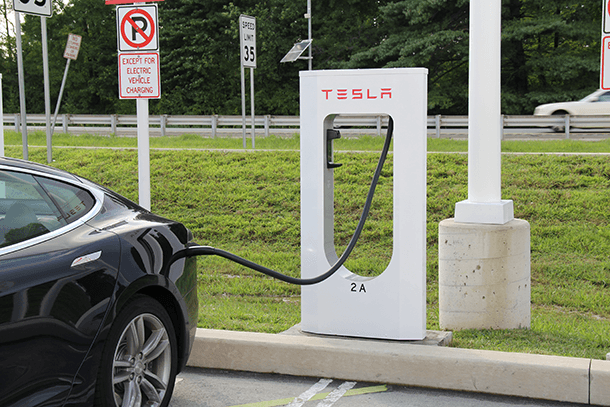Despite low gasoline prices, automakers are moving ahead with affordable electric cars
Networks of Tesla Supercharger Stations will help to encourage people with “range anxiety” to purchase all-electric vehicles like the Model 3.
Back in 2011, when gasoline prices in the US were close to $4 a gallon, President Barack Obama called for automakers to put a million electric cars on the road in America by 2015.
So far, Americans have bought only 400,000 — and with such low gas prices, the whole effort is doomed, right? Maybe not.
For consumers, range and price are the biggest obstacles to purchasing an electric vehicle: a $30,000 electric car barely goes 100 miles on a charge — even less in cold weather. And if you want to go 300 miles on a charge, you have to shell out $100,000 for a Tesla.
But now, both Tesla and General Motors say they will soon sell electric cars that will go 200 miles on a single charge for about $35,000. The Tesla is the Model 3 and Chevy is marketing the Bolt.
According to Jim Motavalli, an environmental writer who specializes in green transportation, when Tesla “drew a line in the sand” and announced it was going to come out with its Model 3, a 200-mile range car for about $35,000, GM decided it would beat Tesla to market — and that’s essentially what happened. The Chevy Bolt was just unveiled at the Detroit Auto Show and the Tesla will debut the Model 3 soon.
And these are just the models getting all the press, Motavalli says.
"The automakers are starting to put out plug-in versions of their cars just as a matter of course — mostly plug-in hybrids with maybe 30 to 40 miles of all-electric range — and they're not making a big deal out of it,” Motavalli says. “It's just becoming part of the background.”
In addition, Tesla is introducing new battery and charging technology that may change how people view electric vehicles.
The new Tesla, for example, will have the ability to connect to Tesla's Supercharger network — stations across the country that are 480 volts and can charge the car in about half an hour. A robust charging network is the key to the success of EVs, Motavalli says.
Tesla has also come out with a new product they call the Powerwall, a battery array that can be used at home. The Powerwall “makes total sense for Tesla,” Motavalli says, because of its close relationship with SolarCity.
“The batteries in the Powerwall are the same as the batteries in the Tesla cars, and they can also serve as backup for the solar panels from SolarCity,” he explains. “There’s a total synergy there. … We’ve long been talking about how the grid will need battery back-up, and this device is essentially a seven kilowatt-hour battery array that you'd have in your house.”
It's a little expensive at $7,000, Motavalli says, but he says the relationship between electric cars and the electrical grid is the wave of the future.
“Vehicle to grid communications is what we’re talking about,” he explains “Essentially, the car can be a rolling battery depository that can plug into the grid and, in times of peak power demand, return power to the grid.”
If just one electric car does that, it's not a big deal, Motavalli says, but imagine 100 cars, all with 40 kilowatt hour batteries connected to a smart utility that can turn on the batteries when it needs them.
“People may not have to turn on, say, a backup generator or what might be a coal power plant that is in reserve,” he says. “The vehicles will still end up being charged when their owners get into them and people will get paid for that. It has the potential to be a pretty good load leveler on the grid.”
In fact, Motavalli envisions cars moving totally away from fossil fuels within the next five to 10 years.
“I think we're headed towards an all-electric fleet on the road,” he says. “We’ve basically reached the point where range is no longer an issue. That was probably the biggest objection. But once you have 200 miles routinely at an affordable price, I think it's inevitable. I think at the same time we are also heading for a renewable energy grid. It's going to be hard to make it work, but I think we'll have an international effort to make that happen.”
This article is based on an interview that aired on PRI's Living on Earth with Steve Curwood.
